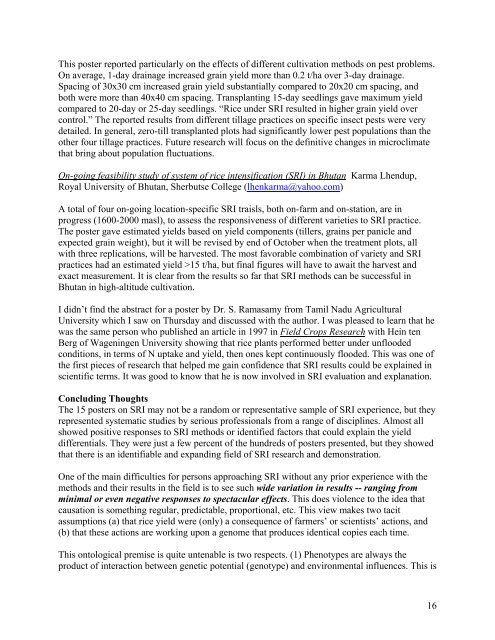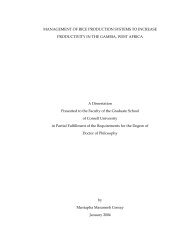REPORT FROM 2ND INTERNATIONAL RICE CONGRESS, NEW ...
REPORT FROM 2ND INTERNATIONAL RICE CONGRESS, NEW ...
REPORT FROM 2ND INTERNATIONAL RICE CONGRESS, NEW ...
Create successful ePaper yourself
Turn your PDF publications into a flip-book with our unique Google optimized e-Paper software.
This poster reported particularly on the effects of different cultivation methods on pest problems.<br />
On average, 1-day drainage increased grain yield more than 0.2 t/ha over 3-day drainage.<br />
Spacing of 30x30 cm increased grain yield substantially compared to 20x20 cm spacing, and<br />
both were more than 40x40 cm spacing. Transplanting 15-day seedlings gave maximum yield<br />
compared to 20-day or 25-day seedlings. “Rice under SRI resulted in higher grain yield over<br />
control.” The reported results from different tillage practices on specific insect pests were very<br />
detailed. In general, zero-till transplanted plots had significantly lower pest populations than the<br />
other four tillage practices. Future research will focus on the definitive changes in microclimate<br />
that bring about population fluctuations.<br />
On-going feasibility study of system of rice intensification (SRI) in Bhutan Karma Lhendup,<br />
Royal University of Bhutan, Sherbutse College (lhenkarma@yahoo.com)<br />
A total of four on-going location-specific SRI traisls, both on-farm and on-station, are in<br />
progress (1600-2000 masl), to assess the responsiveness of different varieties to SRI practice.<br />
The poster gave estimated yields based on yield components (tillers, grains per panicle and<br />
expected grain weight), but it will be revised by end of October when the treatment plots, all<br />
with three replications, will be harvested. The most favorable combination of variety and SRI<br />
practices had an estimated yield >15 t/ha, but final figures will have to await the harvest and<br />
exact measurement. It is clear from the results so far that SRI methods can be successful in<br />
Bhutan in high-altitude cultivation.<br />
I didn’t find the abstract for a poster by Dr. S. Ramasamy from Tamil Nadu Agricultural<br />
University which I saw on Thursday and discussed with the author. I was pleased to learn that he<br />
was the same person who published an article in 1997 in Field Crops Research with Hein ten<br />
Berg of Wageningen University showing that rice plants performed better under unflooded<br />
conditions, in terms of N uptake and yield, then ones kept continuously flooded. This was one of<br />
the first pieces of research that helped me gain confidence that SRI results could be explained in<br />
scientific terms. It was good to know that he is now involved in SRI evaluation and explanation.<br />
Concluding Thoughts<br />
The 15 posters on SRI may not be a random or representative sample of SRI experience, but they<br />
represented systematic studies by serious professionals from a range of disciplines. Almost all<br />
showed positive responses to SRI methods or identified factors that could explain the yield<br />
differentials. They were just a few percent of the hundreds of posters presented, but they showed<br />
that there is an identifiable and expanding field of SRI research and demonstration.<br />
One of the main difficulties for persons approaching SRI without any prior experience with the<br />
methods and their results in the field is to see such wide variation in results -- ranging from<br />
minimal or even negative responses to spectacular effects. This does violence to the idea that<br />
causation is something regular, predictable, proportional, etc. This view makes two tacit<br />
assumptions (a) that rice yield were (only) a consequence of farmers’ or scientists’ actions, and<br />
(b) that these actions are working upon a genome that produces identical copies each time.<br />
This ontological premise is quite untenable is two respects. (1) Phenotypes are always the<br />
product of interaction between genetic potential (genotype) and environmental influences. This is<br />
16
















